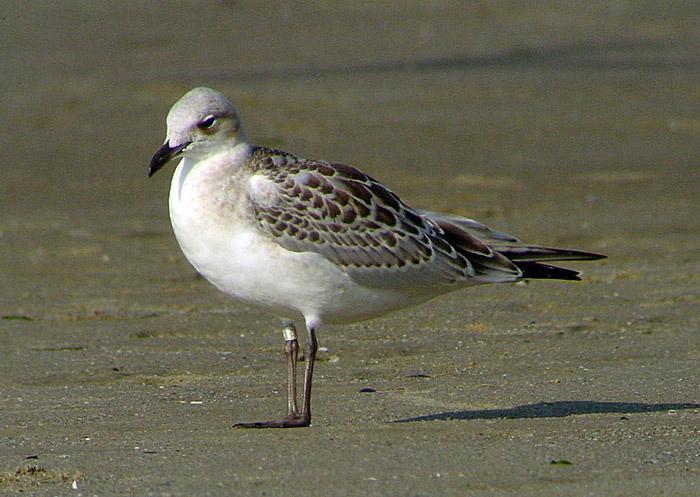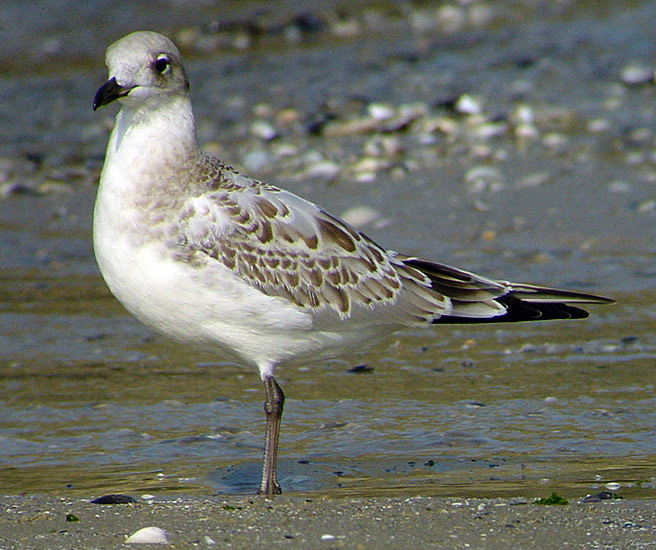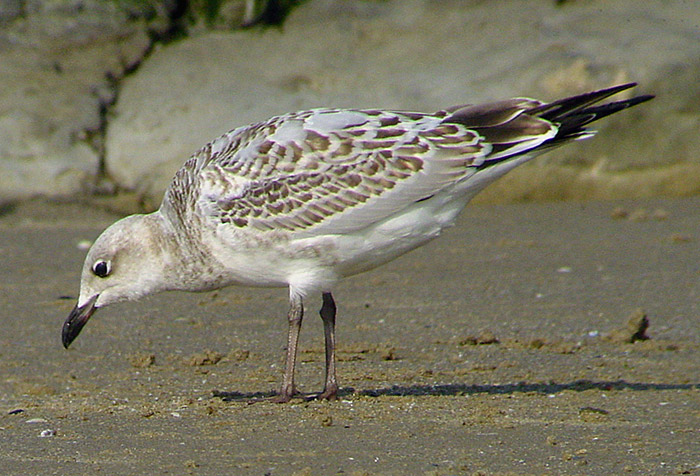 Mediterranean Gull (L. melanocephalus)
Mediterranean Gull (L. melanocephalus)
(last update:
Mediterranean Gull 1cy, August 09 2003, Le Portel /Boulogne-sur-Mer, France (50.42N,1.34E).Three different birds from the same date at Le Portel to illustrate plumage variation and moult in early autumn. In all three note the grey greater covert panel, the striking white eye-crescents, paler base to the bill and brownish legs. In juvenile plumage, the head is uniform pale buffish-brown with slightly darker ear-coverts and a pale throat. Juvenile birds have a blackish smudge in front of the eye and white crescents above and below the eye. The brown colour of the head extends onto the neck, forming a barred collar running down along the sides of the breast to the flanks. The under-parts and rump are white. The scapulars and mantle feathers are deep brown with an inconspicuous dark sub-terminal band and a silvery-white fringe, creating a scaly pattern. The pattern of the scapulars is repeated on the lesser coverts, lower lesser coverts, median coverts, inner three to four greater coverts and upper tertials which also show brown centres and neat silvery-white fringes. They contrast strongly with the central and outer greater coverts, which are predominantly grey, forming a pale bar in the dark inner-wing in flight, as the secondaries are dark blackish-centred as well (but with broad white tips). The inner primaries are largely white-grey, the grey slightly decreasing in the primaries outwards, reduced to parts of the inner-webs in the outer primaries P9 and P10. The under-wing coverts are all-white, but there are neat black tips on the under-wing greater primary coverts. IN some birds the rump and uppertail has some black flecking. The white tail has a clear-cut black sub-terminal band, widest on t1-2, very thin on the outer rectrices (t6 can be completely white). The iris is dark brown, the legs are usually very dark horn, the bill is blackish. Below: Mediterranean Gull 1cy, August 09 2003, Le Portel /Boulogne-sur-Mer, France (50.42N,1.34E).A fresh looking bird in juvenile plumage at the start of it’s post-fledging moult in early August. This bird has dark brown centred scapulars, lesser and inner greater coverts. The median coverts are pale grey with large and dark subterminal “spots”. Note that moult to second generation feathers is still very limited. The scaly pattern in the median scapulars is irregular because some feathers have been dropped. There are a few new feathers on the upper mantle and at least one new scapular. All wing coverts and tertials are juvenile. This bird was ringed as a very young pullus in the Southwest of The Netherlands.
Below: Mediterranean Gull 1cy, August 09 2003, Le Portel /Boulogne-sur-Mer, France (50.42N,1.34E).A bird at the start of its moult to first winter in early August. This pale looking individual shows less contrasts in its plumage than the previous bird. The browns of the scapulars and wing coverts look paler (possibly due to bleaching), the median coverts are less clear grey and the subterminal markings are smaller. The white fringes on the lower lesser coverts and median coverts are clearly worn. There is extensive moult in the mantle and scapulars where several new pale grey feathers have already grown in.
Below: Mediterranean Gull 1cy, August 09 2003, Le Portel /Boulogne-sur-Mer, France (50.42N,1.34E).Another typical juvenile at the start of its first partial moult. This darker looking individual shows less contrasts in its plumage than the first bird. Note the variation in dark feathering on the neack and breast, absent or moulted in the first two pictures but very pronounced in this Med Gull. The centres of the scapulars and wing coverts are plainer brown, most notable in the median coverts where the subterminal markings are less conspicuous. The newly grown mantle and scapular feathers are pale grey.
|


